Maud Heath's Causeway
- Paul Timlett
- Aug 12, 2022
- 13 min read
Updated: Aug 13, 2022
Since originally writing this blog I have updated it. Please read the update at the very end.
A couple of years ago I was perusing my OS maps for Wiltshire for interesting places to walk when I came across something called Maud Heath’s Causeway. I bookmarked it on my computer browser then forgot about it. Recently I was looking again at the map for the Chippenham area and re-discovered the Causeway, so I decided it was time to investigate. I plotted a route and fixed a date to do the walk with my usual walking buddy Stu.
We set off early on a baking hot Friday. I’d found a website where someone had already plotted a route. However, the walk description and the map bore no relation to each other so Stu and I plotted our own route. We parked up in the Sadler’s Mead multi-story car park behind the Olympiad sports centre in Chippenham, just over the road from the station. It cost us £8.40 for the day. We saw signs promising parking for £4 all day somewhere but failed to find it.
So who was Maud Heath, and what is the story behind the Causeway? Maud lived in Wick Hill in the parish of Bremhill in the 15th century. She used to take her eggs and butter to market in Chippenham on foot several times a week, a distance of about 4.5 miles each way. The road was poor and she often slipped and fell, breaking her eggs. She was a childless widow so in 1474 left money to improve and maintain the path for future travellers. Where the path crossed the River Avon at Kellaways it was particularly boggy, so in 1812 it was raised above the floodplain by means of 64 arches, which were largely reconstructed in the 20th century. A charity still maintains the causeway out of her bequest.
There are a number of monuments along the Causeway, but in order to make the walk a manageable length we omitted a few from the route at the Chippenham end, partly because it would have involved stretches along busy roads in the town.
From the car park entrance we went back up to the road into the housing estate and turned right. After a hundred metres or so we turned left into Esmead and followed this all the way to the end to a crossroads where we went straight across into Darcy Close. Shortly after
the beginning of the footpath on the OS map we took a fork to the right by a couple of garages up what looks like a drive. At the end is a residential care home beyond which was a wooden five bar gate. One of the residents, a delightful old man, was standing on the driveway. He insisted he was coming with us on our walk until we told him it was just over eight miles. “Too far” he said “too far”. He may have been right!
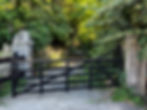
Once through the gate you immediately pass some cottages up to your left – Cocklebury Cottages. After these the gravel track opens out and divides. The fork to the right takes you down to a shared pedestrian cycleway (more of this later) but we continued on the narrow stretch of path ahead. Here we found another of the residents from the care home quietly picking the juicy blackberries by the stile to the right, over which we were to climb.
From here you leave Chippenham behind and head out into open countryside. I won’t bore you with turn-by-turn directions from here as it’s a simple matter of following the footpath on a map. But the route strikes across meadows towards the River Avon and continues in a north north east direction as the river twists away then back to the footpath. Crossing what looked like an irrigation ditch which linked two sides of a horseshoes bend in the river we entered a large meadow that seems to be popular with Chippenham’s dog walkers, of whom we saw several. As we made our way to a bridge in the north corner of the meadow we passed a pill box which was gradually being absorbed by nature.
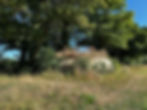
Just after the pill box we came to a wooden bridge that took us across the River Avon.
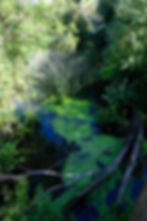
We were aiming for Kellaways on our map, where you will find the legend “Monument” and “Weirs” by Kellaways Mill Farm. As you follow the footpath across the meadows beside the River Avon the arches carrying the road across the floodplain come into view, with little St Giles Church at the right hand (east) end. Aim for the left (west) end of the arches where you will find the first of the monuments we wanted to visit, albeit it marks the midpoint of the causeway between Wick Hill and Chippenham.

The aforementioned monument is a Sundial Pillar erected in 1698. It carries Latin inscriptions to Maud Heath, subsequently translated into English. Astonishingly the sundial on each face was still telling the right time after over 320 years! From here turn to your right on the pathway carried by the arches towards St Giles Church at the far end. We stopped here for a coffee break and sadly found this simple little chapel locked. A church was first built at this location in the early 14th century but being prone to flooding and infestation by rats it had to be moved to its present location on higher ground.
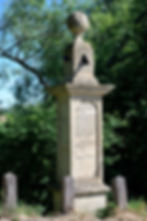
Leaving the arches and chapel behind us we continued along the road. Sadly the entire length of Maud Heath’s Causeway is now a modern road but the worthy lady’s bequest means that there is a pavement alongside it the whole way. The road is not too busy but there are sections where the national speed limit applies so the speeding cars and white vans can feel quite intimidating at times.

We soon reached a row of lovely houses along the road, all of mixed antiquity. This is marked as Broadfield on the map just by Pinnigers Farm. The speed limit drops to 30mph so what little traffic there was became less oppressive. We then came to East Tytherton where the road takes a sharp left and you will find the Maud Heath Centre on a junction.
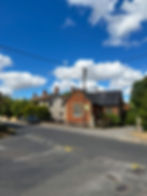
Maud’s Causeway heads up the hill opposite (a right turn at the junction by the green) but do not leave the village yet without looking to your left here. After a driveway to a large house you will see a pink brick building that looks like either a church or a terrace of three houses. It is in fact both. This is the Moravian Church, where Stu and I had not one but two delightful encounters.

Standing at the old iron gate looking at the property we weren’t sure whether or not this was a private house. A man was up a ladder against one of the houses painting the window frames. We carefully called to him (not wishing to startle him) and asked if the buildings were open to the public. He said they were but explained that Ann had the key. We realised that Ann was the very elegant (in a shabby chic, Bohemian sort of way) lady we had just seen exit the large house with a small dog. What followed was a long entertaining conversation with Adrian the decorator. A friendly engaging local, Adrian was extremely interested to know what we were doing and after a wide-ranging and at time hilarious conversation Ann reappeared complete with dog. And key.
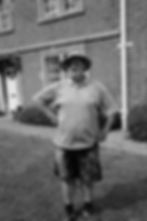
Having taken Adrian’s photograph I offered to take one of Ann. She seemed less keen although I suspect this was false modesty. Her extremely short denim shorts and bright red lipstick (with just a little smudge of the same on her front teeth) belied her 70 years of which she was proud. Having expressed my amazement at her alleged years (for which Stu later scandalously accused me of being shameless) Ann explained the history of the church before leaving us to explore.

The Moravian Church originated in Bohemia (modern day Czech Republic) in the 15th century, following the martyrdom of Hus of Prague. He was influenced by the writings of the English reformer John Wycliffe. In 1457 it was established as a protestant reformed church in Europe. Over years of repression and persecution it reached out with missionary zeal across the world. It had a formative influence on John and Charles Wesley. We are all familiar with Christingle but probably not with the fact that this began in the Moravian congregation of Marienborn in Germany on the 20th December 1747.
Moravians first came to Britain in the 1730s. They often established settlements with their own farms, industries and schools. The church here in East Tytherton dates to 1792 and behind it was a girl’s school. They made extremely fine lace and Queen Victoria supposedly insisted that all her lace be made here. Whilst relocating the church burial ground from the front of the church to the rear many coins and thimbles were found, dropped by the girls as they sewed in the gardens over many years. Some of the coins can be seen in a frame on the wall at the back of the church.

Before leaving East Tytherton by the road opposite the church it’s worth having a look at the beautiful houses on two sides of the green. Here you will also find the next of the monuments on the journey. This one is a rather ugly sundial erected in 1974 to commemorate 500 years of Maud’s bequest. In front of it is a bench dedicated in 1979 by the Old Girls’ Society of Tytherton School (former pupils of the Moravian Girls’ School). Unfortunately the trees have been left to cast a shadow over the face of the sundial so the clock no longer works!

As we trudged along the pavement beside the road up towards Wick Hill, at some point on the road we crossed the Wilts & Berks Canal. However, neither Stu nor I noticed or remembered it! Bizarre since we had walked the stretch of the canal by Pewsham Locks in February this year. All I can say is that we were engrossed in conversation and hadn’t noticed the crossing on our maps or on the ground.
We also managed to miss a footpath on our left that we had intended to take as a way of avoiding the walk along the road to the top of Wick Hill. However, we have a valid excuse for this as the footpath and the sign to it had been removed. This was to become the second theme for the day’s walk. Once we realised we had passed the path we doubled back to look for it. Despite a search of the wider area it was clear the path no longer existed and a hedge planted across the gap where the path should have been. Yet another one for Wiltshire Council.
So we continued beside the road, still on the course of the Causeway, through Bremhill Wick. If you wanted to slavishly follow the causeway this is the best route anyway. The road kicked up and became a very steep climb. Huge respect to the guy who cycled past us up the hill, moving barely any faster than we were. It was tempting to stop at a bench with commanding views back along the Causeway towards Chippenham, but we had momentum behind us and we didn’t want to dwell in the blistering heat by the road any longer than necessary.
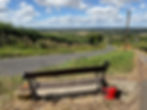
Just before the top of Wick Hill we saw a stone plaque on the wall on the opposite side of the road that marks the beginning (or end) of Maud Heath’s Causeway.

On our side of the road across a field to our left could be seen the impressive final monument of the walk – Maud Heath’s Monument and Statue erected in 1838 by the Third Marquis of Lansdowne and the Reverend Bowles to commemorate Maud’s life. Looking more like an Egyptian Pharoah than a wealthy widow of the 15th century, Maud’s head fell off during a storm in January 1990 and rolled down the hill. Thankfully her head was recovered and reinstalled on her shoulders where it belonged.

We crossed the field to the monument and a stone bench behind, sheltering in the shade of the trees on the escarpment. From this point it is obviously intended that the walker can admire the views and survey the route on which they had travelled from Chippenham. Sadly the trees are so overgrown than not much can be seen. Maud hopefully had a better view from her position atop the pillar towering above our heads. We stopped at the bench for lunch.
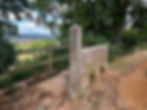
I tried to decipher an inscription on a stone plaque at the base of the monument which apparently says:
“Thou, who dos’t pause on this aerial height, Where Maud Heath’s pathway winds in shade or light, Christian wayfarer in a world of strife Be still, and ponder on the path of life”.
It was at this point that Stu, who never ceases to surprise me, produced a folding saw from his rucksack. To this day I have no idea why he was carrying it or for how long he had been carrying it, but I had to dissuade him from using it on the overhanging branches blocking our view. Having eaten our lunch and drunk some coffee we returned to the road.
Since we had come to the end of our walk along the Causeway it was now a case of finding the most attractive route back to Chippenham. So we crossed the road up which we had walked, and passing the stone plaque we had seen on the wall earlier entered the fields opposite where some builders were building a couple of houses. This is a bridleway that leads to Bencroft Hill and Bencroft Hill Farm. After passing through what appears to be someone's very large garden, the bridleway eventually meets a narrow road by the farm with far reaching views to the White Horse and Landsdown (he gets about doesn’t he) Monument at Cherhill, and south of that to Morgan’s Hill and Furze Knoll.

Turning right along the road we descended steeply towards Stanley passing some lovely cottages on the way. The lane is narrow here and a few cars and white van men passed by, forcing us to tuck ourselves into the hedge. As the road flattened out we reached Stanley Bridge over the River Marden. This is where things were about to get nasty. Really nasty!
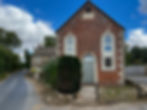
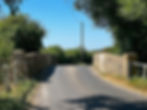
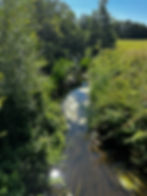
We crossed the bridge and then climbed the stile into the field on our right. The footpath promises a peaceful amble along the banks of the Marden, the tranquil haunt of local fishermen. We passed the flow monitoring station and the grass started to get longer. And longer and longer. Nettles began to appear and then brambles. We ploughed on, our progress becoming slower the whole while. Soon we came to a halt. The way on was completely impenetrable. Then Stu pulled out his saw! He proceeded to hack his way through what was now a jungle.
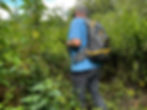
Since it was so hot I was wearing shorts and a T-shirt. My arms and legs were torn to shreds by the brambles and my legs were on fire from the nettle stings for days after. We eventually broke through but encountered yet more problems. Several broken or non-existent stiles (one of which collapsed beneath me) and then the final straw – a wall of maize about 2.5 metres high where the path should have been. A huge field had been planted with the stuff and the route of the footpath not reinstated.
We tracked round the edge of the maize field and finally made it to the end of the path by New Leaze Farm. Here we met a guy on his bike who was about to join the cycle path onto which we had now arrived. We had seen this on the map but being unsure of the legend we weren’t sure that that it was indeed a cycle path and a right of way. This turned out to be National Cycle Network (NCN) 403, a brilliant piece of transport infrastructure. The chap we met said he had also tried to run along the path we had just come along in the past, and had given up. He was astonished we got through. Unlike Stu he obviously didn’t carry a machete with him! He said he’d heard that this whole area is due to be developed for housing and that the farmer had just not bothered to maintain the footpath since he was being bought out. However, he told us the good news that NCN 403 went all the way from the point we were at to the centre of Chippenham, a distance of a couple of miles.
A few days later I put my bike in the back of the car and returned to Stanley Bridge where things had started to go wrong. I wanted to check out the alternative route via NCN 403 avoiding the footpath from hell. This alternative is the one the reader should follow, and which I describe below.
From Stanley Bridge, instead of crossing the stile by the Marden, continue along the road for a few hundred metres until you come to another bridge (see photo below). This bridge goes over NCN 403. Once over the road bridge turn immediately left onto a road that leads up to Studley.
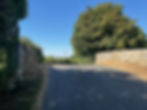
Just after the junction there is a gate on the left, just before Pound Farm, with a signpost and another sign on the gate post saying 403. Take the ramp down to the cycle way where you double back under the road towards Chippenham. The cycle route is a disused railway line and is almost plumb straight all the way back to the outskirts of Chippenham. It is a wide, shared use gravel track so you need to be aware of other users. As I cycled along it the biggest danger to me was dogs – even on this Tuesday morning there were quite a few dog walkers on the track. But as a walker there is little to concern you.
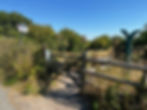
Eventually the NCN 403 comes to a metal bridge over the River Avon. There are two alternatives here. The more pleasant is to cross the bridge and take the zig-zag slope down to the road and a housing estate by the river far below.
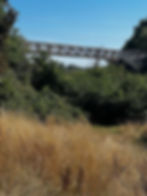
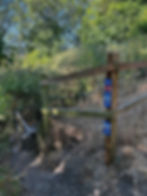
From here you can follow the Avon until the river twists away to the left by Monkton Park Tiny Forest. Here you can follow the signs either to Chippenham Town Centre or Chippenham North. I did the former and the cycle path took me through Monkton Park all the way back to the Olympiad sports centre and car park. This is a busy but pretty route where the Avon swings back to run alongside the cycle path.
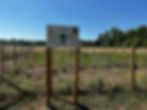
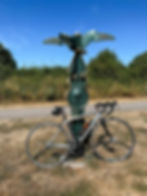
The alternative after crossing the bridge over the Avon is to continue along the cycle path to its end where a ramp takes you up to path from Cocklebury Cottages near the start of the walk, but this would entail retracing your steps through the housing estate. The more attractive route is through Monkton Park.
The route shown on the accompanying map shows the route using NCN 403, which gives a total walk length of 14.3 kms (8.9 miles). It was mostly flat and easy going with just the one steep climb up to Wick Hill. Much of the walk is on roads, albeit relatively quiet and along the Causeway itself all with a pavement of sorts. If you just wanted to see the sights on the Causeway you could do this by car, stopping at each on the way. Bremhill Parish History Group has a terrific page on their website describing all the monuments along the Causeway including those covered by this walk. It also contains a link to a beautifully hand drawn route map. You'll find a link to their website here:
Despite our frustrations with blocked and missing rights of way Stu and I enjoyed the walk and met some fascinating people on the way.

Update 13 August 2022
After posting this blog on the Hidden Wiltshire Facebook Page some material information came to light regarding the farm where we had major problems with the original route ie between Stanley Bridge and New Leaze Farm. It seems that this is one of six Wiltshire Council owned farms in the Chippenham area that has been earmarked for development. The farmer is a tenant of Wiltshire Council. With the future of their farm in doubt we should perhaps have been less judgemental and more understanding of their situation. There is no excuse for blocking rights of way but sometimes we are too quick to jump to conclusions.




